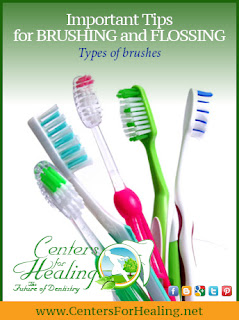Important Tips for BRUSHING and FLOSSING
When it comes to the care of your teeth, Centers for Healing knows that proper brushing and flossing techniques do make a difference in the health of your mouth. Holistic Dentists and traditional dentists both agree that establishing a daily oral care routine should not be difficult. Unfortunately, you face an overload of information from advertisements touting the latest in brushing and flossing products.Types of brushes:
 |
| Brush Types "Important Tips for Brushing and Flossing" |
Toothbrushes come in a variety of sizes and bristle styles. The American Dental Association (ADA) does offer advice to help you choose.
- Ensure that the brush you choose has the ADA Seal of Approval.
- The ends of the bristles should be rounded; jagged ends can damage your gums.
- Most individuals will benefit from a soft bristled brush. Softer bristles will be gentler on tooth enamel, even if you have a heavy hand when brushing.
- The head of the toothbrush should fit comfortably in your mouth. If the head is too large, you may not be able to properly brush your back teeth.
- The ends of the bristles should be rounded; jagged ends can damage your gums.
- Most individuals will benefit from a soft bristled brush. Softer bristles will be gentler on tooth enamel, even if you have a heavy hand when brushing.
- The head of the toothbrush should fit comfortably in your mouth. If the head is too large, you may not be able to properly brush your back teeth.
Dr. David Villarreal suggests "Replacing your toothbrush every three to four months. Frayed or worn out bristles will do more damage than good."
Brushing techniques:
 |
| Brushing Techniques "Important Tips for Brushing and Flossing" |
While getting your teeth clean is important, over-brushing can actually be damaging to your teeth and gums. Also some holistic tooth whitening products allow for safe whitening of teeth. Brushing too hard can wear away the tooth enamel and cause sensitivity.
- Place your toothbrush at a 45-degree angle to the tooth surface.
- Use short, gentle back and forth strokes.
- Clean all of the surfaces of your teeth. The inside, outside and chewing surfaces are all important.
- To brush the inside surfaces of your front teeth hold the brush vertically. Use gentle up and down brush strokes.
- Do not forget to brush your tongue.
- Use short, gentle back and forth strokes.
- Clean all of the surfaces of your teeth. The inside, outside and chewing surfaces are all important.
- To brush the inside surfaces of your front teeth hold the brush vertically. Use gentle up and down brush strokes.
- Do not forget to brush your tongue.
Types of floss:
- Floss is available as waxed or unwaxed string. Waxed floss may glide more smoothly between your teeth.
- The flavoring in floss is designed to make the process more enjoyable.
- Floss tape is used in the same manner as string.
- Floss picks can be useful in reaching back teeth or if you have dexterity problems.
- The flavoring in floss is designed to make the process more enjoyable.
- Floss tape is used in the same manner as string.
- Floss picks can be useful in reaching back teeth or if you have dexterity problems.
Flossing techniques:
To use string floss you will need a piece about 18 inches in length. Wrap the ends a couple of times around your middle or index fingers. Gently work the floss back and forth between each of your teeth. You should be making a “C” shape against the tooth surface.
Be careful not to cut into your gums while flossing. If you notice any bleeding of your gums, consult your dentist. Centers for Healing along with The ADA recommends that you floss your teeth once a day. The time of day and the brushing and flossing sequence do not matter.
Your holistic dentist or traditional dentist is the best source of information when it comes to caring for your teeth. Every individual does have different needs and we will work with you to determine what works best for your situation. If you have questions regarding brushing techniques or which floss or toothbrush to use, ask at your next visit. Keeping your mouth healthy will make your check-ups a pleasant experience.
Visit us online at www.CentersforHealing.net
Centers for Healing is a holistic dental practice. We are located at:
1000 Newbury Rd.; Ste. 225
Newbury Park, CA 91320 (minutes from Malibu)
805-375-2233
805-375-4499
info@centersforhealing.net
Centers for Healing is a holistic dental practice. We are located at:
1000 Newbury Rd.; Ste. 225
Newbury Park, CA 91320 (minutes from Malibu)
805-375-2233
805-375-4499
info@centersforhealing.net
